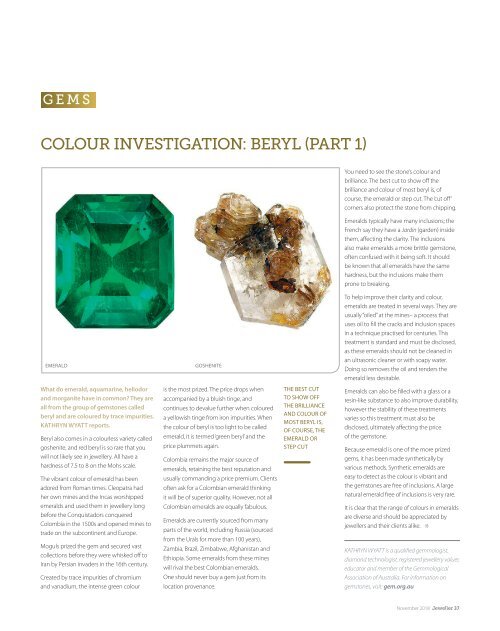Jeweller - November 2018
Create successful ePaper yourself
Turn your PDF publications into a flip-book with our unique Google optimized e-Paper software.
GEMS<br />
COLOUR INVESTIGATION: BERYL (PART 1)<br />
You need to see the stone’s colour and<br />
brilliance. The best cut to show off the<br />
brilliance and colour of most beryl is, of<br />
course, the emerald or step cut. The ‘cut off’<br />
corners also protect the stone from chipping.<br />
Emeralds typically have many inclusions; the<br />
French say they have a Jardin (garden) inside<br />
them, affecting the clarity. The inclusions<br />
also make emeralds a more brittle gemstone,<br />
often confused with it being soft. It should<br />
be known that all emeralds have the same<br />
hardness, but the inclusions make them<br />
prone to breaking.<br />
EMERALD<br />
GOSHENITE<br />
To help improve their clarity and colour,<br />
emeralds are treated in several ways. They are<br />
usually “oiled” at the mines– a process that<br />
uses oil to fill the cracks and inclusion spaces<br />
in a technique practised for centuries. This<br />
treatment is standard and must be disclosed,<br />
as these emeralds should not be cleaned in<br />
an ultrasonic cleaner or with soapy water.<br />
Doing so removes the oil and renders the<br />
emerald less desirable.<br />
What do emerald, aquamarine, heliodor<br />
and morganite have in common? They are<br />
all from the group of gemstones called<br />
beryl and are coloured by trace impurities.<br />
KATHRYN WYATT reports.<br />
Beryl also comes in a colourless variety called<br />
goshenite, and red beryl is so rare that you<br />
will not likely see in jewellery. All have a<br />
hardness of 7.5 to 8 on the Mohs scale.<br />
The vibrant colour of emerald has been<br />
adored from Roman times. Cleopatra had<br />
her own mines and the Incas worshipped<br />
emeralds and used them in jewellery long<br />
before the Conquistadors conquered<br />
Colombia in the 1500s and opened mines to<br />
trade on the subcontinent and Europe.<br />
Moguls prized the gem and secured vast<br />
collections before they were whisked off to<br />
Iran by Persian invaders in the 16th century.<br />
Created by trace impurities of chromium<br />
and vanadium, the intense green colour<br />
is the most prized. The price drops when<br />
accompanied by a bluish tinge, and<br />
continues to devalue further when coloured<br />
a yellowish tinge from iron impurities. When<br />
the colour of beryl is too light to be called<br />
emerald, it is termed ‘green beryl’ and the<br />
price plummets again.<br />
Colombia remains the major source of<br />
emeralds, retaining the best reputation and<br />
usually commanding a price premium. Clients<br />
often ask for a Colombian emerald thinking<br />
it will be of superior quality. However, not all<br />
Colombian emeralds are equally fabulous.<br />
Emeralds are currently sourced from many<br />
parts of the world, including Russia (sourced<br />
from the Urals for more than 100 years),<br />
Zambia, Brazil, Zimbabwe, Afghanistan and<br />
Ethiopia. Some emeralds from these mines<br />
will rival the best Colombian emeralds.<br />
One should never buy a gem just from its<br />
location provenance.<br />
THE BEST CUT<br />
TO SHOW OFF<br />
THE BRILLIANCE<br />
AND COLOUR OF<br />
MOST BERYL IS,<br />
OF COURSE, THE<br />
EMERALD OR<br />
STEP CUT<br />
Emeralds can also be filled with a glass or a<br />
resin-like substance to also improve durability,<br />
however the stability of these treatments<br />
varies so this treatment must also be<br />
disclosed, ultimately affecting the price<br />
of the gemstone.<br />
Because emerald is one of the more prized<br />
gems, it has been made synthetically by<br />
various methods. Synthetic emeralds are<br />
easy to detect as the colour is vibrant and<br />
the gemstones are free of inclusions. A large<br />
natural emerald free of inclusions is very rare.<br />
It is clear that the range of colours in emeralds<br />
are diverse and should be appreciated by<br />
jewellers and their clients alike. i<br />
KATHRYN WYATT is a qualified gemmologist,<br />
diamond technologist, registered jewellery valuer,<br />
educator and member of the Gemmological<br />
Association of Australia. For information on<br />
gemstones, visit: gem.org.au<br />
<strong>November</strong> <strong>2018</strong> <strong>Jeweller</strong> 37


















